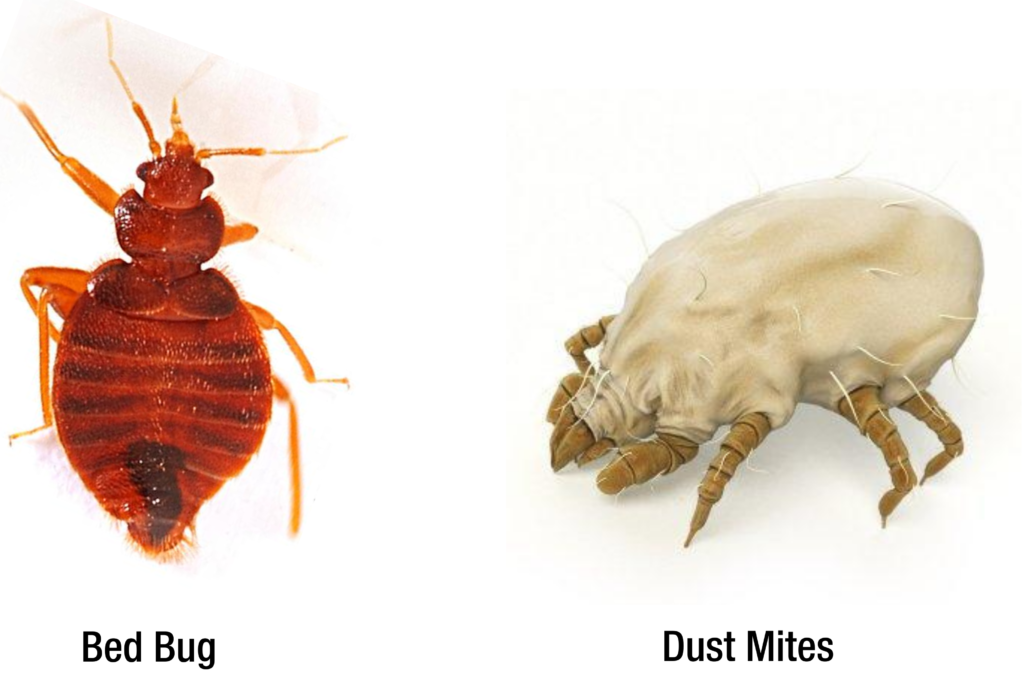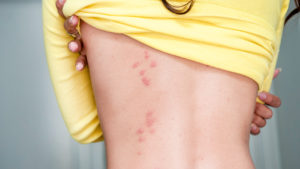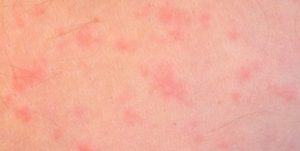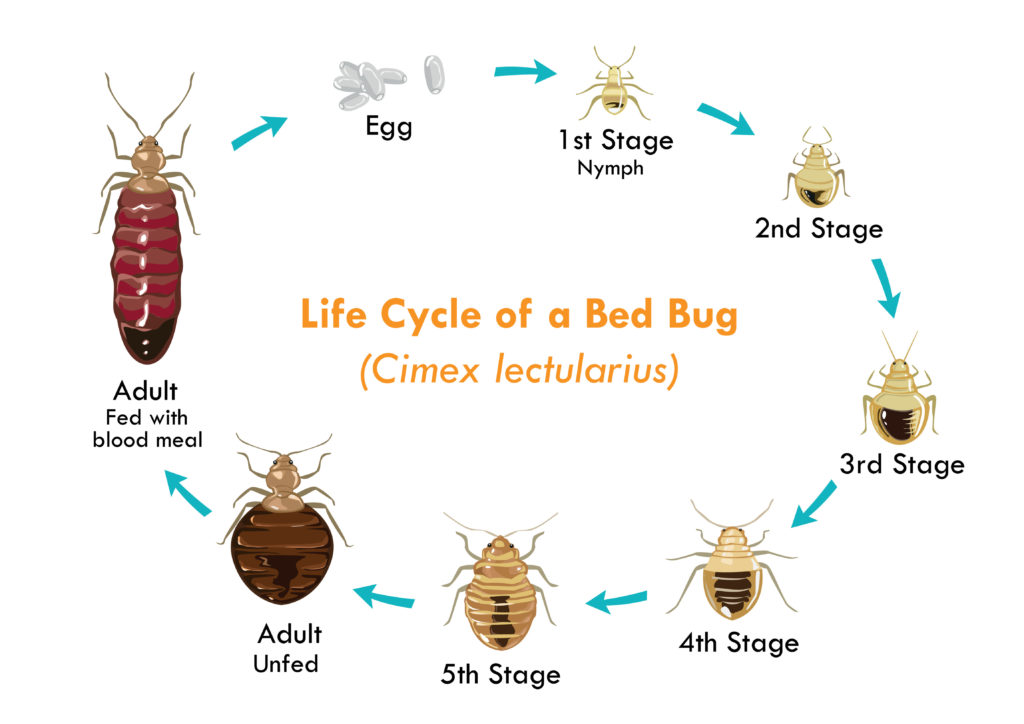Dust mites are commonly confused with bed bugs.
That’s no surprise as both are small and live inside homes.
Nonetheless, correctly identifying these two pests is vital to terminate them.
In this article, we’ll go over all the differences between dust mites and bed bugs.
Let’s dive in.
Dust Mites vs. Bed Bugs: Appearance

- Adult Bed bugs are around 3/16 on an inch (4 or 5mm). They can be compared to the size of a short grain of rice. Dust mites are microscopic. They are typically around ¼ to ⅓ mm long, which is about a fraction of the size of a bed bug.
- Both bed bugs and dust mites have an oval-shaped body.
- Bed bugs have six legs with two forward-facing and four backward facing legs. Dust mites have eight legs with two large mandibles.
- Bed bugs range from light brown to dark brown. Dust mites can range from white to light brown.
- Dust mites have small hairs around their body while bed bugs have no hairs on the body.
- Both bed bugs and ticks do not have wings and cannot fly.
Bed Bug vs. Dust Mites: Distribution
In What Region Do Bed Bugs Live?
Bed bugs are found in all 50 states in the U.S.
Infestations are particularly common in large cities where houses are close together.
Bed bugs are also commonly found in apartments, public transportation, schools, nursing homes, and retail stores.
In What Region Do Dust Mites Live?
Dust mites can be found across the United States, including Alaska.
They prefer warm, humid climates. As such, they are common in the coastal U.S states, ranging from Florida to Washington.
A study by the American Lung Association found that four out of five homes have detectable dust mite allergen levels.
Bed Bug vs. Dust Mites: Habitat
Where Do Bed Bugs Live?
Bed bugs primarily live in bedrooms where food is readily available.
The most common areas to find bed bugs in your bedroom is on mattresses, box springs, headboards, nightstands, pillows.
On furniture bed bugs live in small seams, edges, folds in fabric, and small crevices that offer protection.
They are also commonly found in other regions of the home, including living rooms and home offices.
In severe infestations, they can live on walls, wood furniture, ceilings, and even baseboards.
Where Do Dust Mites Live?
Dust mites live inside homes typically on any fabrics or soft materials around the house.
Some of the most common places that
- Bedsheets
- Mattresses
- Upholstered furniture
- Carpets
- Curtains
- Pillows.
Bed Bugs Vs. Ticks: Diet
What Do Bed Bugs Eat?
Bed bugs drink blood to survive. They commonly feed on humans but will resort to warm-blooded mammals such as dogs, cats, birds, and rodents if humans are not around.
Adult bed bugs can live for 12 to 14 months without a meal.
What Do Dust Mites eat?
Dust mites eat dead skin and hair that fall off humans and other pets.
These pests are also known to eat other such as:
- Cotton fibers
- Paper
- Synthetic materials
- Other mite feces and skin
- Mold
- Fungus
- Pollen
- feathers
Because Dust mites enjoy an abundance of food in a home, their populations can grow extremely large.
A mattress can have anywhere from 100,000 to 10 million mites inside.
Bed Bugs vs.Dust Mites: Bites
Do Bed Bugs Bite?
Yes. Bed bugs bite humans to feed on blood.
When bed bugs bite you, they administer an anesthetic to make it painless. This method allows them to suck your blood without you noticing.
They also release anticoagulants so they can feed on your blood as efficiently as possible.
Once bed bugs finished feeding, they return to their harborage until they need to feed again.
But while bed bug bites are not painful at first, they can eventually become swollen and irritated.
Bed bug bites look like welts and do not have a red spot at the center, unlike other insect bites such as spiders and fleas.
Bed bugs will bite you anywhere there is exposed skin.
Common locations for bed bites include:
- Arms
- Legs
- Ankles
- Back
- Torso
- Neck
- Feet

Do Dust Mites Bite?
Unlike bed bugs, dust mites do not bite, sting, or burrow into your skin.
That said, they can sometimes cause allergic reactions.
Some symptoms of dust mite allergy include:
- Skin rash
- Sneezing
- Coughing
- Runny or stuffy notes
- Itchy eyes
- Itchy skin
- Itchy throat
In some cases, dust mite allergies can trigger asthma and may result in difficulty breathing.

Bed Bugs vs. Dust Mites: Flight
Do Bed Bugs Fly?
While adult bed bugs develop wing pads, they do not fly.
These wing pads do not develop into fully functional wings and have no practical use.
Do Dust Mites Fly?
Dust mites are in the arachnid family and do not fly.
They also do not have wing pads.
That said, dust mites can float through the air or drift on breezes because they are so small.
Bed Bugs vs. Dust Mites: Dangers
Are Bed Bugs Harmful?
Bed bugs do not carry any diseases and are relatively harmless compared to other pests such as mosquitoes and cockroaches.
Having a bed bug infestation can be disruptive to the well being of their human host.
Most people that have infestation suffer from anxiety and lack of sleep.
Bed bug bites can be extremely bothersome, especially for young children.
They can cause excessive scratching, leading to skin infections.
Bed bug bites also cause allergic reactions, and in severe cases, they may need medical attention.
Finally, their bites can transmit parasites, although it’s not common.
Are Dust Mites Harmful?
Dust mites are mostly harmless.
They don’t bite, sting, or carry diseases.
The one harmful effect they have on people is that they cause allergic reactions.
These allergic reactions are typically due to their feces that can get stuck on surfaces or and float through the air.
People with asthma are highly susceptible to the allergens that dust mites leave in your home.
Bed Bugs vs.Dust Mites: Baby
What Do Baby Bed Bugs Look Like?
Bed bugs go through a partial metamorphosis, which means their babies look similar to adults.
Juvenile bed bugs, or nymphs, go into five stages before becoming a full adult.
When bed bugs first hatch, they are only about 1.5 mm long. They have white, oval, and flat bodies.
The nymphs also have two antennas and six legs.
As they mature, they gradually turn from white to dark brown.
Nymphs shed their skins to grow in a process called molting. Every time they molt, they become slightly darker and bigger.
Baby bed bugs need to feed on blood to grow. If they can find enough food, they can become full adults in about six weeks.
They can grow up to 4.5mm long before shedding their exoskeleton one last time.
What do baby dust mites look like?
Baby dust mites are initially born with only six legs.
After the first molt, dust mites grow two additional legs. Dust mites become an adult after two molts.
Bed Bugs vs. Dust Mites: Eggs
What do Bed Bugs eggs look like?
Bed bug eggs are white.
They are about 1 mm in length, similar to the size of two grains of salt.
They are sticky and are typically in clusters inside cracks and crevices.
Bed bug eggs take about two weeks to hatch into a white baby bed bug.
Once hatched, the juvenile bed bug will leave behind its eggshell, which generally looks like white debris.
What Do Dust Mites eggs look like?
Just like adult dust mites, dust mite eggs are microscopic.
Dust mites produce eggs in clusters of about 40 to 80 eggs. These eggs oval and half the size of an adult.
Bed Bugs vs. Dust Mite: Lifecycle
What is the bed bug lifecycle?
Bed bugs go through seven stages of development.
The first stage is egg, followed by five different nymph stages, and finally, the adult stage.
During the nymph stages, bed bugs progressively grow larger.
Nymphs must eat at least once to reach the next phase of development.
Bed bugs eggs take around five to six weeks for bud bugs to reach adulthood.

What is the Dust Mite life cycle?
The Dust Mite life cycle consists of five stages: egg, larvae, and two nymph stages, and the adult stage.
The life cycle of a dust mite takes around one month.
Adult male dust mites typically live between 30 and 60 days while female dust mites live around 90 days.
Bed Bugs vs. Dust Mites: Cause
What Causes Bed Bugs?
Most often, bed bug hitchhikes their way into your home from a location that already has bed bugs.
They can enter your home by attaching themselves to backpacks, luggage, clothes, grocery bags, etc.
In most cases, bed bugs don’t invade your homes from an outdoors.
Bed bugs can also enter your home through used furniture, electronics, and clothing.
These bugs can hide inside used items for up to 12-14 months without eating.
There are some reports of bed bugs walking across power lines and outdoor walls, but this is rare.
What Causes Dust Mites?
Determining the cause of dust mites is very difficult because they are so tiny.
These mites are found across the world and extremely common in households.
Research shows that around 80% of homes tested positive for the pathogen that dust mites produce.
It’s likely that if you have dust mites, they have been in your home for some time.
It is also possible to introduce dust mites to your home because you have come in contact with someone or somewhere with dust mites.
Bed Bugs vs. Dust Mites: How Common Are They?
How Common Are Bed Bugs?
A study found that 20% of Americans have either had bed bugs or know someone who has.
Bed bugs spread easily from one home to another, and clusters of infestations tend to happen.
Bed bugs are one of the most common pests in homes, especially because they do not discriminate.
They will infest any home regardless of social class, cleanliness, or state.
How Common Are Dust Mites?
Dust mites are prevalent in households.
According to the National Lung Association, approximately 80% of houses tested positive for dust-mite allergens.
Not only are they common in households, but they are also extremely hard to eliminate.
Professional pest control companies often claim that you will need to live with some dust mites, but you can reduce the extent of the dust mite infestation.
Bed Bugs vs. Dust Mites: Elimination
How To Get Rid of Bed Bugs?
There are several different methods that you can use to eliminate bed bugs.
The one you choose will depend on the severity of your infestation and budget for treatment.
Common treatments include:
-
- Washing, Steaming, and Vacuuming
- Heat Treatment
- Mattress Encasement
- Fumigation
- Bed Bug Traps
- Chemical Insecticide
How To Get Rid of Dust Mites?
There is no treatment that will guarantee full elimination of dust mites.
That said, you can reduce the size of their population by:
- Using a mattress and furniture encasement to cut off dust mites’ food supply.
- Mopping, sweeping, vacuuming, and dusting your home to remove shelter and food.
- Washing bed sheets, pillowcases, drapery, and other fabrics.
- Steaming clean furniture, mattresses, and carpets.
- Using chemical insecticides around your house.
- Using natural powders such as DE around your home.
